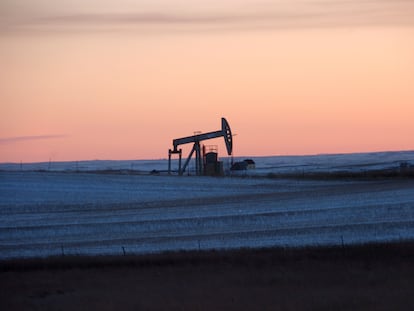Oil industry giants offered $264 million for drilling rights in federal waters in Gulf of Mexico
The auction was the first in the Gulf in more than a year and drew interest from companies like ExxonMobil, Shell and Chevron. The sale was mandated by last year’s climate bill compromise

Oil companies offered a combined $264 million for drilling rights in federal waters in the Gulf of Mexico on Wednesday, in a sale mandated by last year’s climate bill compromise. The auction was the first in the Gulf in more than a year and drew strong interest from industry giants including Chevron, BP and ExxonMobil. But it could further test the loyalty of environmentalists and young voters who backed President Joe Biden in 2020 and were frustrated by this month’s approval of the huge Willow drilling project in northern Alaska.
Developing the Gulf leases could produce more than 1 billion barrels of oil and more than 4 trillion cubic feet (113 billion cubic meters) of natural gas over 50 years, according to a government analysis. Burning that oil would increase planet-warming carbon dioxide emissions by tens of millions of tons, the analysis found.
Winning bids were up 38% from the last auction and marked the most received in a sale since Gulf-wide bidding resumed in 2017.
Chevron USA was the top bidder, offering $108 million for 75 tracts. BP Exploration and Production had $47 million in high bids and Shell Offshore had $20 million in high bids.
The next Gulf lease sale is scheduled in September. It’s unknown how many more the administration could conduct, which could hinder companies’ expansion plans.
Yet analyst Sami Yahya said approval of the ConocoPhillips Willow project in the National Petroleum Reserve-Alaska bodes well for the industry and prospects for future leasing.
“It showed that the Biden administration is likely trying to strike a balance between energy transition and energy security,” said Yahya with S&P Global.
The Department of Interior sale comes two days before a deadline set in last year’s climate bill that Biden signed into law. The measure prohibited leasing public lands for renewable power unless tens of millions of acres are first offered for fossil fuels. That was a concession to get support from West Virginia Democrat Joe Manchin, a fossil fuels industry supporter.
Manchin issued a statement saying the sale results showed the climate bill was “holding this administration’s feet to the fire” to continue fossil fuel production.
The climate law also raised the royalty rate companies must pay on oil they produce. The Biden administration set the rate for Wednesday’s sale at the maximum allowed — 18.75%, versus 12.5% historically — yet that did not appear to curb interest.
The parcels offered at the auction covered 114,000 square miles (295,000 square kilometers) an area larger than Arizona. Like past auctions of similar magnitude, only a fraction of the available acreage — about 2,600 square miles (6,700 square kilometers) — got bids.
The vast majority of the 313 tracts that received offers had only one bidder.
Bids from companies were opened Wednesday in New Orleans, in a state that is economically dependent on the oil and gas industry and especially vulnerable to climate change.
Since it takes years to develop offshore parcels before crude is pumped, the leases could produce oil and gas long past 2030, when scientists say the world needs to have drastically cut greenhouse gas emissions to stave off catastrophic climate change.
Sea level rise is a factor in Louisiana’s steady loss of coastal wetlands, which in addition to harboring a variety of fisheries and wildlife, provide a buffer between inland population areas and hurricanes that scientists say are growing stronger as the world warms.
Louisiana’s complicated relationship with the industry also is illustrated by lawsuits filed by coastal parishes over decades of alleged damage to wetlands from dredging canals to service oil and gas drilling.
ExxonMobil offered almost $10 million in high bids on 69 tracts in the northwest Gulf. The company in 2021 bid nearly $15 million for tracts in the same part of the Gulf, which includes shallow waters — less than 656 feet (200 meters) deep — where oil has mostly played out and there are few active leases.
The acquisitions are likely linked to Exxon’s pursuit of a government-industry collaboration to capture and store carbon dioxide from industrial plants in the Houston Ship Channel, analysts said.
The carbon dioxide would be moved in pipelines and injected deep under the floor of the Gulf of Mexico, a process known as carbon capture and sequestration, or CCS. Oil and gas companies are banking on carbon capture to extend the lifespan of fossil fuel facilities, but critics say the technology is unproven and less effective than switching to renewable energy.
All the leases being sold are for oil and gas exploration and development only, federal officials said.
That means Exxon needs Interior Department cooperation to revise its lease agreements before the company pursues carbon capture, said Justin Rostant, a principal analyst with industry consulting firm Wood Mackenzie.
“There might be some risks associated with whether they’re actually able to use it for carbon capture,” Rostant said. “That is a big question mark.”
ExxonMobil spokesperson Todd Spitler declined to say if there was a link between its bids and the ship channel proposal.
Before bidding results were announced, representatives from the American Petroleum Institute and National Ocean Industries Alliance were calling for more lease sales so companies can start exploration work.
Environmentalists again called on Biden to abide by his campaign pledges to end new drilling on federal lands and water. Diane Hoskins with the group Oceana said the Democrat can “make good on his promise” by including an end to leasing in a long-overdue five-year plan for the Gulf.
A lawsuit challenging Wednesday’s sale is pending before a U.S. District judge in Louisiana. It takes 90 days for the government to evaluate any bids, which means they still could be blocked before being issued. The 2021 sale was subsequently blocked by a federal judge, then reinstated under last year’s climate bill.
“There’s been a lot of talk from the administration about taking climate change seriously and moving our economy away from fossil fuels, and yet we continue to see massive oil and gas projects, both onshore with Willow and offshore in the Gulf of Mexico,” said George Torgun, an Earthjustice attorney representing environmental groups in the pending lawsuit.
Many of the leases sold Wednesday were in deep waters, which Torgun said increases the chance of another major oil spill like BP’s Deepwater Horizon disaster in 2010.
Chevron said in a Monday court filing that it could lose millions of dollars if the leases were blocked.
In coming months the administration plans to auction more than 500 square miles (1,400 square kilometers) of onshore oil and gas leases in Wyoming, New Mexico, Montana, Nevada and other states.
Sign up for our weekly newsletter to get more English-language news coverage from EL PAÍS USA Edition
Tu suscripción se está usando en otro dispositivo
¿Quieres añadir otro usuario a tu suscripción?
Si continúas leyendo en este dispositivo, no se podrá leer en el otro.
FlechaTu suscripción se está usando en otro dispositivo y solo puedes acceder a EL PAÍS desde un dispositivo a la vez.
Si quieres compartir tu cuenta, cambia tu suscripción a la modalidad Premium, así podrás añadir otro usuario. Cada uno accederá con su propia cuenta de email, lo que os permitirá personalizar vuestra experiencia en EL PAÍS.
¿Tienes una suscripción de empresa? Accede aquí para contratar más cuentas.
En el caso de no saber quién está usando tu cuenta, te recomendamos cambiar tu contraseña aquí.
Si decides continuar compartiendo tu cuenta, este mensaje se mostrará en tu dispositivo y en el de la otra persona que está usando tu cuenta de forma indefinida, afectando a tu experiencia de lectura. Puedes consultar aquí los términos y condiciones de la suscripción digital.
More information
Archived In
Últimas noticias
Aquilino Gonell, former Capitol sergeant: ‘If it hadn’t been for the police, the US would be a dictatorship’
A hybrid building: Soccer pitch, housing, and a shopping mall
Europe urges Trump to respect Greenland following annexation threats
Science seeks keys to human longevity in the genetic mixing of Brazilian supercentenarians
Most viewed
- Alain Aspect, Nobel laureate in physics: ‘Einstein was so smart that he would have had to recognize quantum entanglement’
- Mexico’s missing people crisis casts a shadow over World Cup venue
- Alvin Hellerstein, a 92-year-old judge appointed by Bill Clinton, to preside over Maduro’s trial in New York
- Why oil has been at the center of Venezuela-US conflicts for decades
- Cuba confirms death of 32 of its citizens in the US attack against Venezuela










































